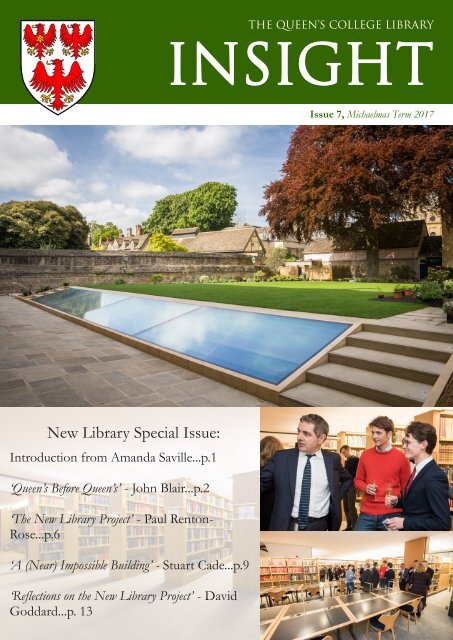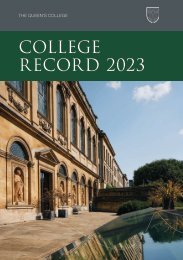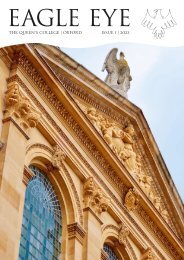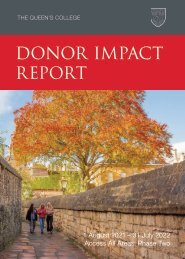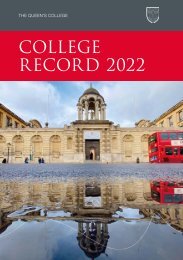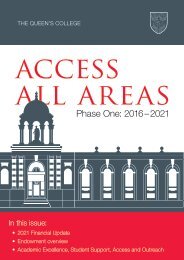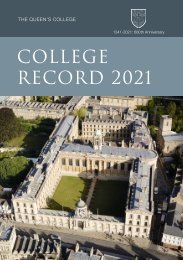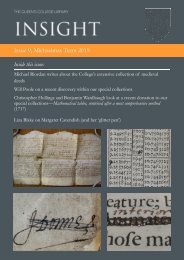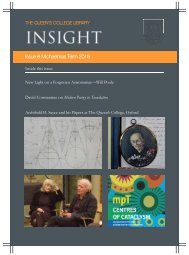You also want an ePaper? Increase the reach of your titles
YUMPU automatically turns print PDFs into web optimized ePapers that Google loves.
The Queen’s College Library<br />
<strong>Insight</strong><br />
Issue 7, Michaelmas Term <strong>2017</strong><br />
New Library Special Issue:<br />
Introduction from Amanda Saville...p.1<br />
‘Queen’s Before Queen’s’ - John Blair...p.2<br />
‘The New Library Project’ - Paul Renton-<br />
Rose...p.6<br />
‘A (Near) Impossible Building’ - Stuart Cade...p.9<br />
‘Reflections on the New Library Project’ - David<br />
Goddard...p. 13
1<br />
elcome to Issue 7<br />
W of <strong>Insight</strong>. The front<br />
cover of this issue is a<br />
somewhat surreal yet<br />
beautiful image of the roof<br />
light to the New Library<br />
appearing to float between<br />
the terrace and lawn of the<br />
Provost’s Garden. It was<br />
taken in May just as the<br />
garden was being replanted<br />
and shows the<br />
copper beech tree in full<br />
leaf, healthy and happy<br />
after two years of adjacent<br />
construction.<br />
THE QUEEN'S COLLEGE LIBRARY INSIGHT<br />
The cover gives it away;<br />
this year’s issue, is, as<br />
promised, a “new library<br />
special” and contains<br />
articles that range from an<br />
account of the preconstruction<br />
archaeological dig to an<br />
assessment of all the work<br />
that has been carried out<br />
on the library buildings<br />
over the last four years.<br />
The first article is by John<br />
Blair, Fellow in Modern History, Anglo-Saxon archaeologist,<br />
former Fellow Librarian and one of the earliest supporters in<br />
College for an underground extension to the Library. John<br />
describes in detail the archaeological dig that took place in<br />
early 2015 in the Provost’s Garden, just before the<br />
construction work began. The results of the dig have cast new<br />
light on the expansion of Oxford eastwards from the original<br />
Saxon Burgh and John’s article brings it all to life. Next time<br />
you come to the Library, if you would like to see some of the<br />
finds unearthed during the dig you will find a cross section of<br />
excavated material on display in the new exhibition case in the<br />
Lower Library.<br />
The second article is by Paul Renton-Rose, Project Manager<br />
for Beard Construction, main contractor for the new library.<br />
Paul was in charge of all aspects of the new library build on<br />
site. His article reveals some of the many complexities<br />
involved in constructing such a bespoke building in a site in<br />
the centre of Oxford, surrounded by Grade I listed structures<br />
and with extremely difficult access. Some of the images in<br />
Paul’s article have reminded me just how challenging a<br />
building this was to construct. This can easily be forgotten as I<br />
sit under the roof light in our beautiful new library enjoying<br />
the fruits of the hard work of Paul and so many of his<br />
dedicated and specialist colleagues, who brought the<br />
Architects’ vision to reality so ably.<br />
Paul’s article is followed by a piece by Stuart Cade, one of the<br />
founding partners of MICA Architects, the company which<br />
earlier this year evolved from Rick Mather Architects, the firm<br />
Rowan Atkinson CBE unveiling the commemorative plaque to declare the New Library officially open.<br />
who designed the Library. I have known Stuart for eleven<br />
years and it is a delight to both of us that the building on<br />
which we have worked together for so long, has now come so<br />
spectacularly to life. Stuart’s article describes the design<br />
concepts behind the building and highlights the expertise of<br />
many of the consultants who worked on the project to design<br />
what he describes as “a (near) impossible building”. I would<br />
like to record my thanks both to Stuart and his colleague<br />
Mandy Franz, who, as Project Architect, made the “near<br />
impossible” into a reality.<br />
The final article is a retrospective by David Goddard, Clerk of<br />
Works and College Project Manager for the new library who<br />
looks back at the last four years of intensive work on the<br />
library buildings starting with the refurbishment project of<br />
2013-14 and culminating in the recent opening of our new<br />
library by old member Rowan Atkinson CBE.<br />
I am very grateful to all the contributors who willingly wrote<br />
for me, many of whom had already moved on to manage other<br />
building challenges whilst writing their articles. I am<br />
particularly grateful to my colleague, Sarah Arkle, whose first<br />
issue of <strong>Insight</strong> this is, who has done such a brilliant job in<br />
producing this issue.<br />
If you have ideas for future articles or indeed would like to<br />
contribute, please contact me at<br />
amanda.saville@queens.ox.ac.uk<br />
Amanda Saville, Librarian, November <strong>2017</strong>
Michaelmas <strong>2017</strong> 2<br />
Q U E E N ’ S B E F O R E Q U E E N ’ S : T H E<br />
ARCHAEOLOGY OF THE NEW LIBRARY AND<br />
OXFORD’S ‘EASTERN EXTENSION’<br />
John Blair, The Queen’s College<br />
he new underground library extends deep into the gravel<br />
T subsoil, and its creation involved the removal of all<br />
human deposits. An archaeological excavation – the largest<br />
ever conducted in modern times in the eastern part of the<br />
walled city of Oxford – was therefore required. The layout<br />
and development of this area between the late Anglo-Saxon<br />
period and the twelfth century have been almost completely<br />
obscure, so the exercise promised a glimpse into the unknown.<br />
That promise was fulfilled: what was uncovered was in one<br />
way predictable, in another very surprising.<br />
The excavation was carried out during 2015 by Oxford<br />
Archaeology under the direction of Richard Brown, and is<br />
described in a preliminary report. 1 Post-excavation work<br />
remains to be completed for the final publication, and some<br />
conclusions will probably be modified, but meanwhile Mr<br />
Brown and O.A. have kindly allowed me to set their findings<br />
in context for the benefit of members of Queen’s. Everything<br />
said here is, however, subject to revision in the light of the<br />
final conclusions.<br />
It is generally agreed that Oxford began as a rectilinear<br />
earthwork fort defending an important Thames crossing, and<br />
also enclosing the minster of St Frideswide (now the<br />
Cathedral) established there around the year 700. 2 The placename<br />
first appears on pennies of King Alfred, minted at<br />
Ohsnaforda in the 890s, but it remains unclear whether the first<br />
fort was built by Alfred, by his immediate successors, or even<br />
conceivably by one of his predecessors. The basic topography<br />
of the core area and its rectilinear defences, enclosing a main<br />
crossroads centred on Carfax, is reasonably clear.<br />
There has been considerable debate, however, about the<br />
eastern half of the walled area between Radcliffe Square and<br />
the East Gate, including the site of Queen’s. The northwards<br />
kink in the line of the late medieval city wall between Broad<br />
Street and Holywell has long encouraged the hypothesis that<br />
the eastern zone was an extension, probably added in the late<br />
tenth or eleventh century. That idea appeared to be confirmed<br />
by an excavation between the Old Bodleian and the Clarendon<br />
Building in 1899, which found a sharp southwards curve in the<br />
revetment of the Anglo-Saxon bank: it is difficult to<br />
understand this except as the north-east corner of the primary<br />
fort. 3<br />
On the other hand, a trench against the inner face of the New<br />
College section of the wall in 1993 disclosed an earlier clay<br />
bank, seemingly identical to the primary northern bank that<br />
had been recognised in 1985 behind St Michael’s Street. 4 That<br />
encouraged some re-thinking: could the whole circuit have<br />
been of a single, Alfredian, build after all? 5 In any case, there<br />
were already enough finds and small-scale observations from<br />
the eastern zone to show that late Anglo-Saxon settlement of<br />
some kind existed there, whether intramural or suburban. 6<br />
There were also the more recent excavations within Queen’s<br />
itself, in the Back Quad (2008) and the Nun’s Garden (2010),<br />
each of which had encountered fragmentary late Anglo-Saxon<br />
pits, including in one case a cut halfpenny of Æthelred II<br />
circulating during 997-1003. 7 It was therefore anticipated that<br />
at least some activity from around the year 1000 would be<br />
identified in the Provost’s Garden.<br />
That proved indeed to be the case (Figure 1). The earliest<br />
occupation (Phase 1) comprised three cellars, measuring<br />
respectively 4 x 2.5 m., 2.5 x 2.5 m., and 1.75 x 1 m. To their<br />
south-west were remains of a metalled lane surfaced with<br />
pebbles, marked by wheel-ruts, and a row of post-holes<br />
suggesting some frontage structure between the largest cellar<br />
and the lane. South and west of the cellars were scattered<br />
rubbish-pits, as usual on such sites. Pottery from the pits and<br />
cellars indicated a late Anglo-Saxon date (though the fill of one<br />
of the cellars contained two sherds of Kennet Valley Ware,<br />
introduced c.1050), and there was another Æthelred II coin, of<br />
c.1009-16.<br />
Subsequent developments (Phase 2a), up to the foundation of<br />
Queen’s in 1342, are at present only dated very broadly. A<br />
system of rectilinear boundary ditches cut some of the Phase 1<br />
features, but is also broadly compatible with the settlement<br />
layout of that date, and may have respected the lane. The<br />
abandonment of the lane is indicated by a rubbish-pit cut<br />
through its surface, containing pottery in the range c.1075-<br />
1150. There are apparently no grounds for thinking that the<br />
topographical configuration represented by the cellars and lane<br />
survived beyond the early to mid twelfth century.<br />
Phase 1 is exactly what we would expect of urban or suburban<br />
activity in the range c.980-1050. Cellars (probably contained<br />
within ground-level timber buildings) are the classic buildingform<br />
found in such contexts. Those from the Provost’s<br />
Garden are at the smaller end of the Oxford range, 8<br />
resembling more closely some examples from proto-towns and<br />
monastic centres like Stafford, Northampton and – more<br />
locally – Bampton. 9 To that extent this looks a less `urban’<br />
environment than, for instance, the frontages of Cornmarket<br />
or Queen Street.<br />
The impression that the late Anglo-Saxon activity was<br />
suburban rather than urban in character is strongly reinforced<br />
by the unexpected alignment of the features. Although the lane<br />
survived in a fragmentary state, it unmistakably ran from westnorth-west<br />
to east-south-east; the wheel-ruts in its surface<br />
show that it was a through-route rather than a purely local<br />
feature. The cellars, and the line of stakes on the frontage,<br />
were broadly aligned on the lane. While one should be cautious<br />
about extrapolating from small observations, it is hard to resist<br />
the obvious conclusion that this lane ran from somewhere in<br />
the region of the Clarendon Building and Hertford College<br />
towards the later medieval East Gate on the High Street<br />
(Figure 2).<br />
This looks like a non-urban settlement layout, which at some<br />
stage was scrapped and overlain by the conventionally<br />
rectilinear topography of the eastern walled area. It does not<br />
tell us when the wall around that area was built, but it does
3<br />
THE QUEEN'S COLLEGE LIBRARY INSIGHT<br />
Figure 1<br />
show that the internal layout did not come to resemble the<br />
rectilinearity of the late Anglo-Saxon core to the west until<br />
after the Norman Conquest. The discovery therefore casts<br />
serious doubt on the hypothesis that the eastern half of the city<br />
was part of the original Alfredian plan, and (setting aside for<br />
the moment the problem of the New College bank) it supports<br />
the earlier view that this was a relatively late extension,<br />
enclosing organic suburban settlement.<br />
The newly-found lane should be seen in relation to Catte Street<br />
(the eastern side of Radcliffe Square), where pre-Conquest<br />
road-metalling of similar appearance was observed in 1980. 10<br />
Together, these lanes now look like a ‘bypass system’, to<br />
channel north-to-south and north-to-east flows of traffic from<br />
the Banbury road down Parks Road, and then around the<br />
outside of the Alfred-period fortress. Whereas Catte Street<br />
presumably led on southwards to a Thames ford, the lane now<br />
discovered under Queen’s would have passed the north-east<br />
corner of the fort and then made for Magdalen Bridge.<br />
When the eastern defences were built (or remodelled as a<br />
continuous circuit), the two lanes would have assumed a new<br />
character as components of the intramural street-plan. Their<br />
northern ends diverged just inside a new gate – Smith Gate –<br />
giving access to the city from Parks Road. Whereas Catte<br />
Street lost its function as a through-route (it was cut short at<br />
Merton Street and then the city wall to the south), the lane<br />
across the Queen’s site would have remained the most direct<br />
route from Smith Gate to the new East Gate. In other words,<br />
it was an earlier incarnation of Queen’s Lane: the present<br />
configuration of sharp-angled bends – so familiar (and at<br />
times so tiresome) to all members of the College – must have<br />
been planned to accommodate blocks of tenements in broad<br />
conformity with the rectilinear layout of the original nucleus<br />
and the extended walls.<br />
When did that happen? Queen’s Lane had assumed its present<br />
configuration by c.1240, when it was known as ‘Thorald the<br />
Tawyer’s Lane’. 11 The replanning must, however, have
Michaelmas <strong>2017</strong> 4<br />
occurred by c.1210 at the latest, since some individual<br />
tenements in the blocks facing the High Street (under the main<br />
front of Queen’s and the shops east of the Lane entrance), 12<br />
and the block facing Catte Street (under Hertford College),<br />
have sets of deeds starting around or just after that date: 13 the<br />
lane must have been diverted before those tenements were laid<br />
out. Oxford has a great wealth of medieval deeds, but<br />
documentation at the level of individual tenements is<br />
essentially post-1200: the fact that the documented properties<br />
were evidently well-established when their deeds start pushes<br />
the replanning episode back into the twelfth century. That is<br />
of course consistent with the excavated evidence that the<br />
original lane was disused, and being cut by pits, no later than<br />
c.1150.<br />
There is a likely connection, though not a necessary one,<br />
between the building of the eastern walls (in their developed<br />
form of a continuous circuit) and the tenemental replanning. It<br />
is in theory quite possible that after the walls were built, the<br />
diagonal lane inside them – now entered at its two ends from<br />
Smith Gate and East Gate – remained in use for decades or<br />
even generations. Alternatively, the walls and the tenementseries<br />
that they enclosed could have been created in a single,<br />
comprehensive town planning exercise. It is normally assumed<br />
that the walls existed at least by the 1080s, but even that is far<br />
from clear. Both in Domesday Book, and in the next<br />
document that mentions it (a charter of 1153-4), the<br />
topographical status of St Peter’s-in-the-East church is left<br />
frustratingly ambiguous : ‘St Peter’s church of Oxford’, rather<br />
than ‘in Oxford’. 14 Even the charter’s description of it as ‘near<br />
the East Gate’ (ecclesia Sancti Petri de Oxenefordia que sita est iuxta<br />
portam de est) is not conclusive, since that might refer either to<br />
the second East Gate (150 metres south-eastwards) or to the<br />
putative original one (250 metres south-westwards).<br />
A different approach to this problem concerns the so-called<br />
‘mural mansions’: the special group of tenements that,<br />
according to Domesday Book, ‘were free in King Edward [the<br />
Confessor]’s time of all customary obligations except armyservice<br />
and repairing the wall’. 15 While the pre-Conquest<br />
origins of the system are thus certain, Hilary Turner’s<br />
topographical analysis in 1990 showed that the ‘mural<br />
mansions’ capable of being located on the ground<br />
concentrated heavily in the north-east part of the developed<br />
city, east of Radcliffe Square and north of High Street. 16 That<br />
cannot reflect late Anglo-Saxon arrangements in any simple or<br />
Figure 2
5<br />
THE QUEEN'S COLLEGE LIBRARY INSIGHT<br />
direct way, since several of the tenements whose proprietors<br />
were charged with wall-duty in a writ of 1227 must have taken<br />
shape after Queen’s Lane assumed its present dog-legged form.<br />
A more straightforward explanation would be that these<br />
tenements do not relate to the Anglo-Saxon system of wallmaintenance<br />
at all, but rather to a twelfth-century extension of<br />
it. On that view, one might envisage an agreement whereby the<br />
Crown allowed the extended walls to be built, on condition<br />
that the burden of maintaining them was apportioned between<br />
the tenants of the new house-plots that were thus enclosed and<br />
protected.<br />
Perhaps, then, there is something to be said for a new<br />
hypothesis: that the eastern walled circuit in its developed<br />
form, and the planned tenements inside it, were laid out<br />
together at a date not long before the abandonment of the<br />
settlement on the Provost’s Garden site by the 1150s. In Henry<br />
I’s reign Oxford was already recovering from its post-Conquest<br />
depression, and growing fast. 17 Another obvious possibility is<br />
that the Anarchy years of 1139-53 (which despite the political<br />
chaos were an era of strong economic growth. 18 ) created a<br />
compelling incentive to defend the valuable church of St Peter,<br />
and the now densely-settled zone between it and the city wall.<br />
It would have helped that the two powerful magnates with a<br />
direct interest in this part of eastern Oxford and Holywell<br />
manor were Angevin supporters, well-placed at court: Henry<br />
d’Oilly, the heir of Robert d’Oilly who had held St Peter’s<br />
church and Holywell in 1086, and Henry of Oxford, Matilda’s<br />
local henchman, who built a massive Romanesque house in the<br />
west of the city. 19 The 1153-4 charter mentioned above is an<br />
(ultimately ineffectual) grant by Henry d’Oilly to Oseney Abbey<br />
of St Peter’s church, which at that point was firmly in the<br />
clutches of John of Oxford, Henry of Oxford’s son and future<br />
bishop of Norwich. 20 John may well have been responsible for<br />
the sumptuous Romanesque rebuilding of the church that still<br />
largely survives (now St Edmund Hall library), and he certainly<br />
enjoyed a large and apparently complex residence west of St<br />
Peter’s churchyard, occupying what is now the eastern half of<br />
the Back Quad at Queen’s. 21 If the extension of the walls and<br />
the replanning of the area inside them happened in, say, the<br />
1140s, it is almost certain that the two Henrys were involved in<br />
one way or another.<br />
At this point we need to take a step back, and consider the<br />
status and fortunes of St Peter’s church: it may have been the<br />
single most important influence on the urban developments to<br />
its west. Although the early ecclesiastical heart of Oxford was<br />
certainly St Frideswide’s, there is persuasive circumstantial<br />
evidence that St Peter’s-in-the-East was also an Anglo-Saxon<br />
monastic complex, possibly one of a series established on the<br />
peripheries of Mercian centres by King Alfred’s daughter<br />
Æthelflaed. 22 During the tenth to twelfth centuries, it was often<br />
the fate of formerly independent minsters to be annexed as<br />
essentially the private property of secular and ecclesiastical<br />
magnates. Domesday Book (which unfortunately says nothing<br />
here about pre-Conquest arrangements) makes it clear that this<br />
had happened to St Peter’s by 1086: both the church and its<br />
manor of Holywell were controlled by the Norman baron<br />
Robert d’Oilly. 23 Its later twelfth-century status, as the personal<br />
church and residence of a great curial ecclesiastic, looks equally<br />
typical. The absence of early sources should not disguise from<br />
us the former wealth and status of this church, which would<br />
certainly have been surrounded by a substantial precinct and<br />
associated buildings.<br />
We have no evidence for what that complex was like (the<br />
broken circle shown on Figure 2 is purely schematic), but it<br />
could have included a significant part of what would become<br />
the walled extension north of High Street. There are hints of it<br />
in thirteenth-century deeds describing the tenements on the<br />
easternmost part of the Queen’s site: Bishop John’s house<br />
comprising a ‘messuage with houses, orchard(?) and the whole<br />
courtyard … in the churchyard of St Peter’s’ (mesuagium cum<br />
domibus et uirgulto et tota curia … in atrio Beati Petri), and the<br />
tenement to its south ‘in St Peter’s churchyard’. 24 An odd<br />
feature of these descriptions is that they ignore the intervening<br />
Queen’s Lane, which certainly existed when they were written.<br />
The explanation is presumably that they were carried over<br />
from earlier documentation, dating from a time before the<br />
replanning, when St Peter’s and its peripheral structures<br />
dominated the local landscape.<br />
If we take another step backwards, that perspective helps to<br />
set the early eleventh-century occupation in context. If the<br />
Queen’s site was suburban in the sense that it was outside the<br />
eastern rampart of the city, it was also suburban in the sense<br />
that it developed on the periphery of an Anglo-Saxon minster:<br />
many eleventh-century towns began as what an Alfred-period<br />
translator (rendering Bede’s phrase urbana loca into Old<br />
English) called ‘minster-places’. 25 This was therefore a place of<br />
a rather special and unusual kind, arising from the original<br />
placement of St Peter’s some way outside the fort: a suburb, as<br />
it were, twice over. And indeed it offers a classic illustration of<br />
the kind of small-scale cultivation for urban consumption that<br />
underlies so many places of this kind. The Domesday account<br />
of Holywell manor in 1086 mentions 23 men ‘having little<br />
gardens’ (hortulos habentes). 26 Smallholders of this kind, who may<br />
have combined obligations to their lords with marketgardening<br />
and craft production, were very common of the<br />
edges of eleventh-century towns. 27 Maybe some of their wares<br />
were sold from the roadside buildings now identified under the<br />
Provost’s Garden.<br />
Having said all that, there remains the problem – a big and<br />
important one – of the New College bank. The feature<br />
observed in 1993 is scarcely diagnostic physically: a city<br />
defence constructed in the twelfth century would probably still<br />
have been earthen, 28 and it is not obvious that the bank<br />
material of a rampart built in, say, 1150 would look different<br />
from one built in, say, 1000. However, Optically Stimulated<br />
Luminescence (OSL) results just released point to the startling<br />
conclusion that this feature, or parts of it, was constructed in<br />
the eighth century. 29 This remarkable new evidence (for<br />
immediate access to which I am deeply grateful to Ben Ford of<br />
Oxford Archaeology) raises implications that cannot be<br />
considered properly here, let alone answered. Possibly the<br />
eighth-century earthwork was a linear bank – or even a<br />
monastic enclosure around St Peter’s – that survived as a<br />
relict landscape feature to be incorporated into the twelfthcentury<br />
defences. It is hard to see it as an integral part of the
Michaelmas <strong>2017</strong> 6<br />
Alfred-period fort; rather, that must have been built<br />
immediately west of some structure surviving from the period<br />
of Mercian control. At all events, the suburban character of<br />
the occupation around the year 1000 can scarcely be<br />
reconciled with the earthwork being a coherent barrier<br />
between town and countryside at that stage. For the moment<br />
this question must remain unresolved, but debate will certainly<br />
continue.<br />
The Anglo-Saxon landscape of the Queen’s site is very deeply<br />
buried: under the twelfth-century urban replanning, under the<br />
late medieval College buildings, and finally under their<br />
Baroque successors. There is no possibility of exploring it<br />
except by deep excavation, which is why it has remained so<br />
mysterious hitherto. Over the past decade, Queen’s has had<br />
the confidence and courage to augment its facilities with a new<br />
kitchen, lecture-room and library. That has been at the cost of<br />
considerable disruption, now happily behind us. An<br />
unexpected bonus along the way has been a significant<br />
contribution to understanding the origins and early growth of<br />
Oxford.<br />
Notes and references<br />
1. R. Brown, Provost’s Garden, The Queen’s College, Oxford: Post-<br />
Excavation Assessment and Updated Project Design (unpublished client<br />
report, Oxford Archaeology, September 2016).<br />
2. J. Blair, Anglo-Saxon Oxfordshire (Stroud, 1994), 52-4, 61-3, 87-92,<br />
146-52; A. Dodd (ed.), Oxford Before the University (Oxford, 2003).<br />
3. Julian Munby in Dodd (ed.), Oxford Before the University, 172-83.<br />
4. Paul Booth in Dodd (ed.), Oxford Before the University, 183-6.<br />
5. Julian Munby in Dodd (ed.), Oxford Before the University, 24-5,<br />
concluding that `the proposed eastern extension remains really<br />
quite difficult to reconcile with the archaeological evidence’.<br />
6. J. Blair, Anglo-Saxon Oxfordshire, 161.<br />
7. A. Norton and J. Mumford, `Anglo-Saxon Pits and a Medieval<br />
Kitchen at The Queen’s College, Oxford’, Oxoniensia, 75 (2010),<br />
165-217, at pp.177-9; S. Teague, A. Norton and A. Dodd, `Late<br />
Saxon, Medieval and Post-Medieval Archaeology at the Nun’s<br />
Garden, The Queen’s College, Oxford’, Oxoniensia, 80 (2015), 143<br />
-85, at pp.147-8.<br />
8. J. Blair, Anglo-Saxon Oxfordshire, 162-4; Dodd, Oxford Before the<br />
University, 35-41.<br />
9. J. Blair, Building Anglo-Saxon England (Princeton, 2018), Fig. 131.<br />
10. Dodd, Oxford Before the University, 260, 397.<br />
11. H.E. Salter, Survey of Oxford, I (Oxford Historical Soc. n.s.14,<br />
1960), 160 (tenement NE 230); Cartulary of Oseney Abbey, ed. H.E.<br />
Salter, I (Oxford Historical Soc. 89, 1929), 269-71<br />
12. Salter, Survey, I, 135-47 (tenements NE 173-95, especially 175,<br />
177, 183, 190 with starting deeds no later than 1210).<br />
13. Salter, Survey, I, 92-8 (tenements NE 131-6, especially 131 with a<br />
starting deed of c.1220).<br />
14. Great Domesday Book fo. 158v; H.E. Salter, Facsimiles of Early<br />
Charters in Oxford Muniment Rooms (Oxford, 1929), No.73.<br />
15. Great Domesday Book fo.154.<br />
16. H.L. Turner, `The Mural Mansions of Oxford: Attempted<br />
Identifications’, Oxoniensia, 55 (1990), 73-9; cf. O. Creighton and<br />
R. Higham, Medieval Town Walls (Stroud, 2005), 39-40, 81, etc.<br />
17. Blair, Anglo-Saxon Oxfordshire, 177.<br />
18. Here I cannot resist recalling that my predecessor, John<br />
Prestwich, made this point very powerfully in a lecture that I<br />
heard as an undergraduate, in about 1974. I hope he would have<br />
relished the thought that urban replanning from the Anarchy<br />
period lies directly under Queen’s.<br />
19. J. Blair, `Frewin Hall, Oxford; a Norman Mansion and a<br />
Monastic College’, Oxoniensia, 43 (1978), 48-99, at pp.49-64.<br />
20. Salter, Facsimiles of Early Charters, No. 73.<br />
21. Salter, Survey, I, 152-3 (tenement NE 208); Cartulary of Oseney, I,<br />
276-9.<br />
22. Blair, Anglo-Saxon Oxfordshire, 112-13.<br />
23. Great Domesday Book fo. 158v.<br />
24. Salter, Survey, I, 152-3 (tenements NE 208-9); Cartulary of Oseney,<br />
I, 276; Cartulary of the Hospital of St John the Baptist, ed. H.E. Salter,<br />
I (Oxford Hist. Soc. 66, 1914), 344.<br />
25. J. Blair, The Church in Anglo-Saxon Society (Oxford, 2005), 330-41.<br />
26. Great Domesday Book fo.158v.<br />
27. C. Dyer ,`Towns and Cottages in Eleventh-Century England’, in<br />
H. Mayr-Harting and R.I. Moore (eds.), Studies in Medieval History<br />
Presented to R.H.C. Davis (London, 1985), 91-106; Blair, Church in<br />
Anglo-Saxon Society, 340-1.<br />
28. Cf. Creighton and Higham, Medieval Town Walls, 178-84.<br />
29. Results communicated by Jean-Luc Schwenninger in July <strong>2017</strong>.<br />
Thanks also to David Radford for his help with this and other<br />
sites.<br />
John Blair is a Fellow in History here at The Queen’s College and<br />
Professor of Medieval History and Archaeology. He was appointed to his<br />
present position at Queen’s in 1981. Outside his academic duties, he<br />
maintains a long-standing involvement in practical archaeology, and in the<br />
worlds of building and landscape conservation.<br />
The New Library Project<br />
Paul Renton-Rose, Beard Construction<br />
For Amanda<br />
une 2015 saw the start of the work on site for the new<br />
J<br />
library project, it had taken years of preparations by the<br />
various architects & design teams and now, with the<br />
archaeology complete, it was time to start the excavation. This<br />
transformed the Provost’s Garden into a construction site and<br />
started the engineering process of the New Library. The<br />
design team had set the bar very high with a wall to wall<br />
excavation that had to be executed with great care & precision<br />
to fit the library into the garden area without disturbing the<br />
surrounding 1690’s library building, listed walls, not forgetting<br />
the reportedly 200-year-old wisteria and copper beech tree.<br />
Protection to the west side of the library facade was formed<br />
with a 5.5-metre-high screen made from steel supports, ply<br />
and Monoflex sheeting. The protection of the historic wall on<br />
the south elevation was completed and agreed with all parties<br />
so piling could commence.<br />
A temporary support for the 38-tonne piling machine required<br />
a designed reinforced piling mat of approximately 1000 tonne<br />
of stone, this was imported, constructed and plate tested<br />
before we allowed the piling to proceed. A strong and stable<br />
platform is essential to keeping the rig flat on the ground and<br />
not allow excessive movement in the mast.<br />
Supporting the ground and historic parts of the Grade I listed
7<br />
THE QUEEN'S COLLEGE LIBRARY INSIGHT<br />
building and associated<br />
Grade II listed walls,<br />
took great skill and<br />
ingenuity on behalf of<br />
the construction team.<br />
The designed secant<br />
piling was located<br />
around the excavation<br />
up against the lines of<br />
the existing structures,<br />
and in one case within<br />
100mm of the library<br />
facade.<br />
Weekly monitoring of<br />
Piling machine<br />
t h e s u r r o u n d i n g<br />
buildings made sure that the ground support measures that had<br />
been put in place were working and could be constantly<br />
adjusted if required.<br />
Monitoring concrete before and after casting<br />
Whilst the New Library piling and excavation were being<br />
executed, the dismantling of the joinery in the Lower Library<br />
took place: labelling, scheduling, photographing all the parts,<br />
careful removal and transferring off site for 15 months into<br />
storage for later inclusion. Trying to keep a low profile in the<br />
back of the College garden with the only access via Queens &<br />
New College Lane was not easy. Trying to ship out soil;<br />
approximately 8861 tonnes of excavated materials and at the<br />
same time bring in 3000 tonnes of concrete and new materials<br />
through the tight<br />
restrictions of the<br />
Lane, was challenging<br />
to say the least. We<br />
restricted the sizes<br />
and width of the<br />
delivery vehicles and<br />
in some cases the<br />
m a t erials b eing<br />
delivered. As a result,<br />
daily monitoring and<br />
cleaning of the lane<br />
by our staff, and<br />
weekly cleaning with<br />
the road sweeper, was<br />
necessary.<br />
The pump used during the build to place concrete<br />
Contractors worked hard over the 18 months to keep<br />
members of the public and tourists safe whilst escorting the<br />
delivery trucks and materials safely to the site, sometimes, with<br />
agreement of all parties and Oxford City Council, in the early<br />
hours of the mornings to reduce the risk to the public and<br />
students.<br />
After extensive archaeology for approximately 3 months by<br />
Oxford Archaeology the site was passed over to us to progress<br />
with the works, during the bulk excavation one of the ground<br />
work team spotted and unearthed an earwax and tooth pick<br />
which was returned to the College for display (approximate<br />
length 10cm).<br />
The finds liaison officer dated this to 13th-15th (medieval)<br />
which would correspond to the early arrangement for The<br />
Queens College (before the wholesale rebuilding of the<br />
17th/18th) when this area seems likely to have been used as a<br />
quarry for building materials; pits for toilets; and the dumping<br />
of rubbish. The artefact, an expensive item for the time, was a<br />
personal grooming item likely to have been accidentally<br />
dropped down the toilet by a student or scholar.<br />
Toothpick/earwax implement found during the excavation<br />
With the type of reinforced concrete structure proposed, most<br />
buildings are built to a B.S. or E.N. (British or European<br />
standards) for location and verticality, in all instances the<br />
structures have exceeded this quality standard allowing the<br />
design team certainty in their design.<br />
Every reinforcement bar was engineered, designed, drawn,<br />
scheduled, delivered to site, cut, bent and then positioned by<br />
hand. Each was measured to fit its correct location to carry out<br />
the job it is required to do. 138 tonnes of steel reinforcement<br />
has been placed by hand (as shown in the photo below) by<br />
experienced skilled workers.<br />
Escorted deliveries along Queen’s lane to the<br />
construction site<br />
Our great band of<br />
banksmen from Curtis
Michaelmas <strong>2017</strong> 8<br />
Interesting Statistics for the Project<br />
299 concrete piles were used to support the ground &<br />
structure of the new building. They also anchor the library<br />
in place; pile length of 3000 metres (3km) if positioned end<br />
to end.<br />
There are 10 ground source piles which extend 50 metres<br />
below the building basement level.<br />
8861 tonnes of excavated soil was removed.<br />
2000 cubic metres of concrete was delivered and pumped<br />
into the ground (approximately 5000 tonnes).<br />
138 tonnes of reinforcement strengthens the concrete<br />
which supports the library structure.<br />
94,338.5 hours have been employed on site by the various<br />
trades (this excludes the production time of offsite<br />
manufacture and work by office or design staff).<br />
9km of electrical wiring was used.<br />
60 separate contractors have had an input to the works on<br />
site, many of them have a specialist knowledge for a<br />
particular part of the build.<br />
737 site personnel & visitors have been inducted and<br />
managed on site.<br />
The location of the site mid way along Queens Lane required a<br />
smaller than normal concrete truck which could deliver the<br />
concrete directly to the site along the very narrow road and<br />
around the tight corners in the lane. Our happy band of lads<br />
on the logistics team escorted the concrete trucks to and from<br />
the site daily ensuring the safety of the public and monitoring<br />
the vehicles passing safely through the historic lane. This<br />
amounted to over 2000 vehicle movements.<br />
Small concrete lorry escorted to and from the site<br />
Creating the ground-level main entrance to the New Library<br />
brought many challenges: working inside the historic Grade I<br />
listed building in a working library; making sure the vital<br />
services of the library were not disturbed, and, ensuring all of<br />
the designed construction fitted into the space required; lift,<br />
staircase and final finishes. It was one area of the build that<br />
had all the makings of a big problem, and could have all gone<br />
terribly wrong. However, it had been planned and designed<br />
well, the design fitted like a glove, millimetre precision in fact,<br />
no second chances.<br />
Positioning the 7-tonne piling rig into the building through the<br />
listed structure onto the timber floors was a concern to<br />
Contractors Design Services, our temporary works engineer,<br />
but with an engineered solution to strengthen the floors we<br />
quickly overcame the issue, and the piling rig operated easily to<br />
form the temporary piles and the permanent piles. The<br />
entrance in the Lower Library was hand excavated (about 450<br />
cubic metres) around the piles and support structure, with the<br />
new structure in place the temporary works were removed and<br />
temporary piles disposed of. Great care was taken throughout<br />
not to create too much disruption or disturbance to the<br />
College by the groundwork team.<br />
The Lower Library panelling was removed in order to install the new<br />
sliding glass door<br />
Reinstatement of the lower<br />
library panelling and<br />
bookcases, which arrived<br />
back from the Botley Road<br />
storage depot piece by<br />
piece, was carried out<br />
lovingly by the Cliveden<br />
conservation team of<br />
carpenters. The Lower<br />
Library panelling was<br />
refurbished, refinished and<br />
polished to match the<br />
existing panelling. Finally,<br />
the new glass sliding door<br />
was installed behind the<br />
panelling.<br />
The design for this project<br />
aimed to limit the visual Work by Cliveden Conservation to<br />
aspect of a complex reinstall the Lower Library Panelling<br />
mechanical and electrical design by concealing as much of the<br />
ventilation and electrical systems within the structure of the<br />
building. Under the raised flooring is the supply air ducting<br />
and the majority of the electrical services which are supported<br />
on hand crafted cable trays and baskets.<br />
What lies beneath: example of the cable tray and basket used underneath<br />
the flooring to conceal complex systems used in the build
9<br />
THE QUEEN'S COLLEGE LIBRARY INSIGHT<br />
The new library has 10<br />
bore holes for the<br />
ground source heat<br />
pump (GSHP) which<br />
extends down under<br />
the building by 50<br />
metres. It uses the<br />
stable underground<br />
temperature of the<br />
earth to heat and cool<br />
the building. They<br />
Ground source pipework<br />
achieve this by connecting the building and the earth via a<br />
network of underground pipes. These pipes use water to<br />
transfer heat from the earth to the building heat pumps to heat<br />
it and from the building to the earth to cool it.<br />
Ground source heat pumps are a lot more energy efficient and<br />
cost effective than traditional heating systems found in most<br />
homes and buildings. This is because although they only need a<br />
small amount of electricity to run, heat pump systems don’t<br />
burn any kind of fuel on site to produce their heat and use only<br />
the natural temperature of the earth as an energy generating<br />
method. This offers significant reductions in energy bills and<br />
CO2.<br />
Although not visible to the students, the plant room is very<br />
compact; hiding most of the mechanical & electrical services<br />
required to run the complex ventilation and power systems for<br />
the building. Having been very carefully designed and<br />
engineered by the design team the professional team of skilled<br />
craftsmen had to ensure all items fitted into their correct spaces<br />
and the systems all worked together.<br />
both men & women, who have put their heart and soul into<br />
their work every day for the last 20 months ensuring the<br />
project is finished to the highest quality which you can see<br />
today – it has been more than just another job; real people<br />
make things happen.<br />
I would like to list all the men and women on site who played<br />
their part in making this scheme a success but the list would be<br />
very long; 60 contractors have had an input to the works on<br />
site and some of them have had a very specialist input.<br />
There have been lighter moments in the project, New College<br />
Lane was closed for a week during the filming of ‘The<br />
Mummy’ <strong>2017</strong> (Tom Cruise). Careful planning on site and<br />
good liaison with the film location crew meant this did not<br />
stop the works or prevent materials reaching the site.<br />
Images from the set of The Mummy in New College Lane<br />
All projects rely on a team effort which, when working<br />
correctly, provides for a better product. I believe we have had<br />
a brilliant team of people working on the project, both on site<br />
& off site supporting the various functions of the build<br />
process. I would like to thank everyone involved for a job well<br />
done.<br />
I trust the College and students will value and enjoy the space<br />
created for many years to come.<br />
Paul Renton-Rose is a Project Manager for Beard Construction. His job<br />
role is to manage the construction process and liaise with clients,<br />
stakeholders, suppliers and to ensure Beard have the resources in place to<br />
complete the project safely and to a good standard. He says of his career,<br />
after 44 years in industry “I still find construction amazing… how did<br />
they build those pyramids?”<br />
Pipework in the Plant Room<br />
The safety systems installed are ready to be used should the<br />
need arise; these include an aspirating fire detection system,<br />
water misting fire suppression system, gas suppression to the<br />
Historic Collections Archive Store and plant room, emergency<br />
lighting and battery backup.<br />
This plant room has been the most compact and complex<br />
system I have been involved with, as most of the services are<br />
inter-linked and connect to the internet, they are also linked<br />
and monitored by the College Building Management System<br />
(CBMS).<br />
People make buildings, not machines. It is easy to forget about<br />
the many talented, professional, skilled workers and craftsmen,<br />
“A Near Impossible building” -<br />
designing and building the new<br />
library at Queen’s College<br />
Stuart Cade, Rick Mather Architects and MICA<br />
Prologue<br />
he team at Rick Mather Architects (RMA) are delighted<br />
T to see the opening of the New Library, which was<br />
completed earlier this year in time for a busy Trinity Term. As<br />
we often find, the transition from building site to occupied<br />
building has been rapid and it is great to see the new spaces<br />
immediately popular with the hardworking students of<br />
Queen’s.
Michaelmas <strong>2017</strong> 10<br />
We last wrote for <strong>Insight</strong> in 2015 at the outset of the<br />
archaeological and enabling works prior to the<br />
commencement of the main building contract. The subsequent<br />
two years have seen the completion of this preliminary work,<br />
the completion of the new building and, lastly, the reworking<br />
of the existing Lower Library. At time of writing the remainder<br />
of the collections were being moved into the new spaces and<br />
the entire build is now fully operational.<br />
Looking back, RMA commenced work on a scheme for The<br />
Queen’s College Library project in 2006 following a two-stage<br />
design competition. Our work has included detailed designs<br />
f o r b o t h t h e<br />
refurbishment of the<br />
Upper and Lower<br />
Library (completed in<br />
2013); designs for the<br />
large subterranean<br />
extension that is the<br />
New Library and<br />
alterations to the<br />
Lower Library. The<br />
latter has allowed us to<br />
create a generous new<br />
entrance space, and<br />
install a bespoke lift,<br />
which connects the An early design concept montage<br />
new and old buildings.<br />
In the 40-year history of Rick Mather Architects, the project,<br />
one of the last that Rick worked on, is one of our most<br />
significant. For the office it is significant in terms of the<br />
challenge posed by the site: its rich and ancient history; the<br />
precious medieval walls; the Grade 1 listed Library it adjoins<br />
and the magnificent buildings that it extends.<br />
The project is also significant in terms of what it achieves;<br />
extending a landlocked Library where all possible contiguous<br />
(and otherwise) extensions had been considered and found<br />
unfeasible. Furthermore, realizing a scheme that works on<br />
paper is a further challenge in practice. Given the logistical,<br />
planning, archaeological, heritage and physical parameters the<br />
large team feel that the project has built a (near) impossible<br />
building.<br />
The design<br />
The new building and its connection to the existing 1692<br />
Library is a bespoke building in all regards.<br />
The construction has employed 21st Century technologies<br />
allied with traditional trades and crafts to create a crisp and<br />
simple contemporary design and the conservation of historic<br />
spaces; equally marrying large-format, frameless glass with rich<br />
tailor-made oak carpentry.<br />
The designs include a new ground floor entrance; a reworked<br />
Lower Library and a new 8000sq/ft. below-ground extension<br />
containing vital new facilities. The Library extension contains<br />
extensive storage and plant facilities in the western half and a<br />
new reading room and office in the eastern half where all<br />
spaces are bathed in natural light. The effective use of every<br />
millimetre was carefully considered and the building was<br />
planned to maximize use of all walls and corners. In total the<br />
design creates 18 new distinct ‘spaces’ for the Library and<br />
associated Archive. In summary, the project has provided:<br />
A new Reading Room<br />
The reading room is the major new addition to the library. The<br />
r o o m<br />
provides a<br />
light and open<br />
space for 36<br />
users. It is top<br />
lit by a large<br />
new roof<br />
light, which<br />
emits natural<br />
light into the<br />
new building<br />
w h i l s t<br />
a f f o r d i n g<br />
The new reading room<br />
views to the west elevation of the existing Library. Space is<br />
maximized with shelving fitted against all walls. The Reading<br />
Room also gives access to two extensive areas of open book<br />
storage. Firstly, the open shelves; these flank the Reading<br />
Room and entrance and house half of the main circulating<br />
collection. They are configured to guide visitors through the<br />
new spaces; the shelves tapering to open the vista to the<br />
Reading Room. Secondly, and adjoining the Reading Room on<br />
the north and east side, are two linear spaces of roller racking<br />
to maximize storage and house the library’s reserve collections.<br />
Historic Collections and Archive Store<br />
Deep within<br />
t h e n e w<br />
building is the<br />
H i s t o r i c<br />
C o l l e c t i o n s<br />
and Archive<br />
Store, which<br />
provides space<br />
f o r t h e<br />
c o l l e g e ’ s<br />
s i g n i f i c a n t<br />
a n t i q u a r i a n<br />
collection in a<br />
secure and<br />
temperature<br />
c o n t r o l l e d<br />
environment.<br />
The design of<br />
the space<br />
c o m b i n e s<br />
Some of the historic collections in the new HCAS<br />
p r a c t i c a l i t y<br />
and aesthetics;<br />
maximizing storage but with a clean, simple look in deliberate<br />
contrast to the rich material it houses. The HCAS is provided<br />
with its own secure Reading Room; the Feinberg Room which<br />
borrows light from the large main roof light and has space for<br />
up to 4 Special Collections Readers to use simultaneously.
11<br />
THE QUEEN'S COLLEGE LIBRARY INSIGHT<br />
A new Peet Library of Egyptology<br />
A separate study room for the College’s Egyptology collection<br />
is located in front of the entry gates to the new reading room<br />
so as to be accessible to non-Queen’s members. The Peet has 4<br />
central reader spaces and a large study table. The walls are lined<br />
entirely with bookshelves to maximize space for this important<br />
collection. At the entrance, a glass screen is provided by a<br />
double-sided display case allowing Egyptian artefacts to be<br />
displayed in the round; visible to all Library visitors.<br />
A new multi-purpose space<br />
In the southwest corner a new space is provided for up to 15<br />
students for group study; small seminars and teaching for the<br />
wider College. The space has a sophisticated AV fit-out to<br />
enable it to support a variety of uses.<br />
Lower Library<br />
The Lower Library<br />
h a s b e e n<br />
sensitively returned<br />
to its original<br />
arrangement, as<br />
conceived by C. R.<br />
Cockerell in 1845,<br />
through careful<br />
e d i t i n g a n d<br />
removal of a series<br />
of later additions.<br />
The extra space in<br />
the new building<br />
Newly reconfigured Lower Library<br />
has allowed the<br />
aisles to be cleared of added shelves. Removing the<br />
overcrowded office and other late additions has returned the<br />
entrance space to its intended grandeur. East and West aisles<br />
are opened and provided with new seats and lockers and the<br />
cross aisle is open providing a view from the new Provost’s<br />
Garden to Back Quad. The Lower Library now has 22 high<br />
quality individual reader spaces and 8 new standing desks.<br />
A new entrance<br />
The Lower Library works also include a new entrance where<br />
the existing rehung oak doors have been paired with a new<br />
frameless glass sliding door. This new door provides both an<br />
environmental and<br />
security barrier for the<br />
Library, whilst also<br />
giving a spectacular view<br />
from the north end of<br />
the library to the<br />
southern end of<br />
Hawksmoor’s Front<br />
Quad.<br />
The new entrance to the library<br />
The entrance vestibule<br />
also provides a new lift<br />
linking both existing and<br />
new buildings and<br />
ensuring accessibility to<br />
t h e u n d e r g r o u n d<br />
extension.<br />
A responsible design<br />
The building employs advanced environmental design. 50m<br />
piles transfer thermal energy from deep below the building to<br />
the new air handling and heating/cooling coils in the plant<br />
room. This technology works both to pre-heat the building’s<br />
heating systems in the winter and vice-versa in summer using<br />
the known thermal stability of deep ground temperatures. The<br />
low energy strategy provides for both the new underground<br />
building and now also provides heating and cooling for both<br />
levels of the existing Library.<br />
The building further minimizes energy consumption by use of<br />
its physical location in the ground and maximizes the heat-sink<br />
qualities of its concrete structure – the space was exceptionally<br />
cool even in the June and July heatwave.<br />
The new building uses a single, efficient Menerga air handling<br />
unit which uses adiabatic technology (water) as a cooling<br />
medium and in-turn requires less energy to heat or cool. The<br />
unit similarly recycles and exchanges waste energy at a higher<br />
rate than conventional systems. Electrical energy consumption<br />
is minimized with responsive systems and LED lighting<br />
controlled by a new Building Management System.<br />
Finally, consideration of embodied energy was central to our<br />
material selection with 92% materials (stone, timber, soil and<br />
concrete) sourced within 50 miles of the site. In the case of the<br />
new garden, reused and recycled stone from the existing<br />
garden could be used again for the new terraces and paths.<br />
A new garden<br />
The underground library is topped with a new Provost’s<br />
Garden, bounded by two listed mediaeval stone walls, the<br />
existing library and the Provost’s Lodgings. The new design<br />
for the garden responds to the needs of the Provost (and their<br />
family) and the College - balancing privacy and flexibility –<br />
whilst recreating a serene and verdant garden.<br />
Aerial view of the new Provost’s garden<br />
We worked closely with Landscape Architect Jeremy Rye to<br />
devise a scheme that worked for all and could work effectively<br />
as a ‘roof garden’. The garden is a complex geometry of subtle<br />
slopes and gradients to provide the appearance and utility of a<br />
‘flat’ lawn whilst mediating between many different levels. The<br />
geometry also disguises the new roof light from the east end of
Michaelmas <strong>2017</strong> 12<br />
the garden and the new private lodgings from the west<br />
(Library) end. Most importantly, the new roof light and all<br />
interventions are invisible in the long view to the west<br />
elevation and statues of the existing Library.<br />
Queen’s with a number of opportunities to reconfigure and<br />
extend for future use.<br />
The build<br />
Construction of the new building commenced in spring 2015<br />
and ran for 89 weeks through two kind winters completing in<br />
spring <strong>2017</strong>.<br />
The main contractor, Beard, are a very experienced and skilled<br />
local company with a great deal of experience working in<br />
collegiate Oxford – and specifically at Queen’s, having<br />
completed the kitchen project in 2009. Their expertise and<br />
familiarity assisted in the two major challenges of the build:<br />
getting material to and from the site and digging a large hole<br />
that was both very close to and beneath existing historic listed<br />
structures.<br />
View of the new garden from the Provost’s Lodgings—looking toward the<br />
library<br />
The garden provides two terraces, a circuit of paths and a<br />
variety of new beds and space for a vegetable garden and new<br />
garden store. The paths and ramps make all areas of the<br />
garden accessible to wheelchair users. The below ground<br />
structure and overall garden design has been carefully<br />
configured to safeguard the existing magnificent copper beech<br />
tree which has been carefully protected throughout and we are<br />
pleased to say is prospering in its new setting.<br />
The challenge of building close to existing structures involved<br />
much careful design<br />
work, as well as<br />
buildability studies<br />
being carried out by<br />
the design team<br />
before the project got<br />
to site. Regular<br />
movement checking<br />
was completed in<br />
advance of going on<br />
site to ensure no<br />
damaging movement<br />
of the existing walls,<br />
Library or Lodgings<br />
was taking place.<br />
The forming of the<br />
piles and internal<br />
concrete box was a<br />
careful and steady<br />
process of piling, The new basement level in its early stages<br />
digging, supporting,<br />
backfilling, bracing and finally - with the lid - forming a rigid<br />
waterproof concrete box. The careful iterative process of<br />
building in-the-ground was particularly acute in forming the<br />
link between the new building and Lower Library, where a<br />
bespoke design was used to tunnel beneath the existing<br />
Library footings forming a new basement 5m below the<br />
functioning Library.<br />
Aerial view of the construction site where the garden was replanted<br />
Fitting out the building<br />
Choosing fixtures and fittings for a building is always an added<br />
pleasure for architects and we have greatly enjoyed being<br />
involved in designing the tables, insignias, manifestations, and<br />
fixed furniture together with selecting the new reading chairs,<br />
and other details.<br />
Elsewhere<br />
Benefitting the wider College, the project frees-up 4500sqft for<br />
reuse. Liberated spaces include an extensive basement and<br />
above ground spaces on Front and Back Quad providing<br />
The waterproof box was completed with the installation of 4<br />
super-sized frameless glass roof lights along the eastern edge.<br />
These enormous pieces were carefully manoeuvered into place<br />
by a number of cranes and small lifting machines in early <strong>2017</strong><br />
to finally seal the new building.<br />
The fit-out of the building was no less complex than the<br />
structural works with extensive special fittings to be concealed<br />
and accommodated. The invisibility of air-conditioning,<br />
heating and other services is the result of careful coordination<br />
between joinery and environmental design where the new<br />
shelving often straddles low-level ducts, and grilles. At the top<br />
of shelves, extract ventilation occurs together with much of
13<br />
THE QUEEN'S COLLEGE LIBRARY INSIGHT<br />
the lighting for the building.<br />
Bespoke shelving lines the walls of every space and is tailored<br />
to provide everything from shelf space, displays, signage and<br />
space for oversized parts of the collection.<br />
Architect, we worked with on the designs for the new<br />
Provost’s Garden.<br />
The new carpentry was also carefully coordinated with a large<br />
number of glazed screens, which are a major feature of the<br />
interior; dividing rooms and enclosing the new lift. Careful<br />
detailing and handling of glass ensured that large panels could<br />
be used and the overall effect of a reflective internal glass ‘face’<br />
in the entrance was able to be maintained.<br />
The finer finishing touches include acoustic ceilings; fabric<br />
wrapped panels; the installation of display cases and exquisite<br />
timber paneling in the Lower Library by Cliveden<br />
Conservation.<br />
In statistics:<br />
The project sank 299 concrete bearing and retaining piles<br />
each 30m long.<br />
We augured 10 special thermal piles each extending 50m<br />
into Oxford clay.<br />
On completion of the piled perimeter 8900 cubic metres of<br />
soil and gravel was excavated for reuse elsewhere.<br />
There are 5km of electrical, AV and data cabling, and 800<br />
linear metres of new shelving.<br />
Epilogue<br />
Having now seen the project realised, we are pleased that many<br />
key aspects of the original concept and design have worked as<br />
intended. Creating a bright day lit new library space was central<br />
to the aims of the design project, and many studies were carried<br />
out at all stages to test this. The roof light aperture, roof slope<br />
and height were all iteratively adjusted to ensure that light<br />
penetrated the new space(s) in the most effective way possible.<br />
The ultimate objective being to provide a comfortable space<br />
that belied its below-ground position. Similarly, we are pleased<br />
that the new Library is invisible from many views – an unusual<br />
objective for architects. The invisibility has been aided by the<br />
planting of the garden which has been established and was in<br />
use this summer.<br />
We are conscious that the project was disruptive for both<br />
College and its neighbours. Whilst a great deal was done to<br />
mitigate this, major projects are always noisy. Considering the<br />
scale of the project, many have remarked that Beard’s excellent<br />
management minimized disruption in a significant way.<br />
We would like to thank the design team of specialist<br />
consultants that we have employed to complete the project.<br />
Eckersley O’Callaghan, our structural and civil engineers,<br />
engineered a complex invisible ‘box’. Atelier Ten, our service<br />
engineers, who devised a sophisticated and effective low energy<br />
strategy (in addition to designing a most beautiful and compact<br />
plant room!)<br />
The full team also included a skilled Acoustician (Sandy Brown<br />
Associates); Fire Consultant (Simon Ham); Planning<br />
Consultant (Nik Lyzba); Health and Safety Consultant<br />
(Gardiner and Theobald) and Jeremy Rye who, as Landscape<br />
The ‘beautiful and compact’ plant room designed by Atelier Ten<br />
Working for Queen’s has been both professional, and a<br />
pleasure in all aspects. The College is an experienced ‘building’<br />
College and its representatives understand the complexities<br />
and nuances of construction and its processes. We would like<br />
to thank Becky Beasley and Angus Bowie for their pivotal role<br />
in the project happening and for leading the internal<br />
consultation process; particularly over the last 4 years. This<br />
project is Amanda Saville’s third new library (her best so far)<br />
and the project has been very fortunate to have her experience<br />
and expertise. Collectively, the College and client team led by<br />
David Goddard have provided experience and fostered<br />
collaboration with all parties, providing a constant presence<br />
while the project was on site; all with calmness and good<br />
humour.<br />
Finally, and particularly at this point, we recognise the privilege<br />
as architects of completing a new building for Queen’s, adding<br />
to a magnificent range of historic buildings and gardens. It is<br />
equally a privilege to add to the College’s much-loved and well<br />
used Library and to see it well prepared for the future.<br />
Stuart Cade is a founding partner of MICA Architects and a<br />
longstanding partner at RMA. Stuart has worked in Oxford for 20<br />
years and has led the practice’s 14 completed projects in Oxford including<br />
work on Oxford’s own Ashmolean Museum. Stuart is currently leading<br />
MICA’s major new commission at Jesus College, in central Oxford.<br />
Reflections on the new library<br />
project<br />
David Goddard, Project Manager<br />
The completion of the New Library marks the end of a four<br />
year programme of intensive redevelopment of our library<br />
facilities. The new underground library construction was the<br />
final phase of work which included the complete overhaul and
Michaelmas <strong>2017</strong> 14<br />
refurbishment of both the existing Upper and Lower Library<br />
spaces. The culmination of this period of work has also aptly<br />
coincided with the 675 th Anniversary of the Foundation of The<br />
Queen’s College.<br />
reader spaces were occupied, along with those in the existing<br />
Upper and Lower libraries. To me this clearly demonstrated<br />
that not only were the additional spaces necessary, but that the<br />
effort, time and energy the College invested in this project had<br />
been entirely worthwhile.<br />
From this: the construction site in early stages...<br />
The work undertaken was comprehensive, and provided the<br />
opportunity to explore, review and develop each and every<br />
aspect of this facility to ensure that the maximum potential<br />
could be achieved from such a valuable College asset. I am<br />
confident that, following completion of this extended and<br />
complex period of work, Queen’s can rightfully be proud of<br />
having one of the finest library buildings within the University.<br />
It is rare that the opportunity arises to become involved in<br />
such a prestigious project and all the more so when it involves<br />
working within, and alongside, such important Grade I listed<br />
buildings. In addition, the area of works was located in the<br />
footprint of a space that was previously occupied by a very<br />
precious garden. I consider myself fortunate that the College<br />
had the faith to entrust me with the responsibility of being The<br />
Project Client Manager. This role not only enabled me to have<br />
influence over the decision making processes, regarding design<br />
changes but also allowed me to ensure satisfactory<br />
coordination between all stakeholders and for overseeing an<br />
appropriate standard of quality control.<br />
The responsibility was particularly testing as in addition to<br />
such a complex project brief, careful thought had to be<br />
afforded to the site logistics. These included very complex and<br />
challenging access constraints and the need to minimise the<br />
detrimental impact on academic life both within Queen’s and<br />
the four neighbouring colleges.<br />
These challenges were eased considerably by the<br />
understanding, cooperation and sacrifice shown by everyone in<br />
College, and in particular the current Junior Members who<br />
gave such selfless support to the cause even though many<br />
would not get to enjoy the benefits of the completed library. I<br />
feel it only right to take this opportunity to sincerely thank<br />
everyone who played a part, no matter how small.<br />
As you are aware the New Library was completed for the<br />
beginning of Trinity Term <strong>2017</strong> and it was very rewarding to<br />
observe that within a short time of it’s opening, all the new<br />
To this: A view into the underground extension to the library<br />
In conclusion, despite the significant challenge that the library<br />
refurbishment programme and new building project have<br />
posed to the College for a number of years, it is reassuring to<br />
witness the successful completion, and we can now look<br />
forward to addressing some of the other areas in College that<br />
require investment and development.<br />
David Goddard is the Clerk of Works here at Queen’s College. He is<br />
responsible for all aspects of building maintenance. He leads a team that<br />
ensures the College is kept in working order whilst being sensitive to the<br />
nature and appearance of the Grade I and Grade II listed buildings<br />
The Queen’s College Library <strong>Insight</strong><br />
Published by The Library, The Queen’s College,<br />
Oxford, OX1 4AW<br />
Copyright The Queen’s College, Oxford, <strong>2017</strong><br />
All rights reserved<br />
ISSN 2049-8349
15<br />
THE QUEEN'S COLLEGE LIBRARY INSIGHT<br />
Liquid Legacies<br />
Beer and Brewing at<br />
The Queen’s College<br />
June<br />
to<br />
Winter<br />
<strong>2017</strong><br />
This small exhibition<br />
is located in the<br />
display cases in the<br />
Queen’s College<br />
Upper Library.<br />
Non-members of the<br />
College, please<br />
contact us in advance<br />
to arrange an<br />
appointment.<br />
01865 279130<br />
library@queens.ox.ac.uk<br />
The Queen’s College Chancellor Ale<br />
‘Some may question its flavour, but none its potency’<br />
J.M. Kaye, The Queen’s College Record, 1936


